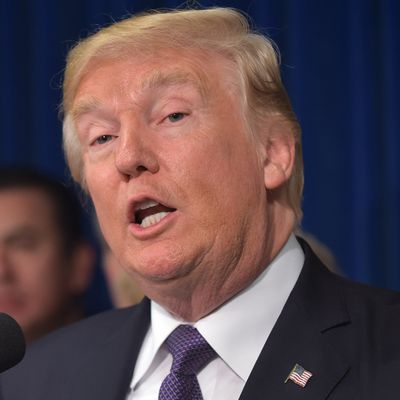
Most of the discussion among progressives (and some #NeverTrump conservatives) about the 45th president’s future in office involves short-term efforts to limit his power by elevating less dangerous people in his administration, taking away his party’s congressional power in the 2018 midterms, impeaching him, or forcing a quick retirement, preferably in disgrace. There is less talk about denying him a second term. That’s partly because 2020 seems impossibly far away, particularly as measured in Trump years, in which every day, week, and month can be excruciatingly long.
But another factor inhibiting much 2020 talk — other than the intramural Democratic focus on identifying the 46th president of the United States — is the belief that a calamity like the 2016 presidential election cannot possibly happen twice in just four years.
Probably sensing overconfidence, former Clinton White House political director Doug Sosnik offered Democrats a rude awakening at Politico with a provocative column arguing that Trump’s not in that bad a position heading toward 2020.
Sosnik points out several reasons Trump could win reelection despite terrible-looking approval ratings. For one thing, as 2016 (and 2000) showed, you can win a presidential race while losing the popular vote. For another, most of these bad approval-rating numbers we all keep reading are poorly screened for actual likelihood to vote in 2020 (many are based on “all adults” samples). And then there’s the relatively strong durability of Trump’s support levels within his electoral “base,” almost regardless of what he does or how it affects the country.
But Sosnik’s central point is that the very corrosive forces that made Trump’s election possible in 2016 will likely lower the share of the vote he needs for reelection:
[T]he continued decline in support for both political parties works to Trump’s advantage. The lack of voters’ faith in both parties increases the probability that there will be a major third-party candidate on the 2020 ballot. It will also lead to other minor-party candidates joining the presidential race. The multi-candidate field will further divide the anti-Trump vote, making it possible for him to get reelected simply by holding on to his current level of support.
Now, that’s a bit of a reach.
You may recall that former New York mayor Michael Bloomberg flirted with the idea of launching a major “centrist” third-party presidential race in 2016, particularly if Bernie Sanders had won the Democratic nomination. In the end, Bloomberg concluded that he’d take more votes away from Hillary Clinton than from Donald Trump, and didn’t want to be responsible for the possibility of a President Trump.
There’s no particular reason to think Bloomberg himself (who will turn 78 in 2020) will consider a 2020 run, though there are other billionaire “centrists” out there who could replace him in hypothetical three-way races, if they chose an independent route instead of the more efficient approach of competing for a Democratic nomination that may have no clear favorite (depending on who else makes that race). Like Bloomberg in 2016, any potential “major” indie candidate could also bow out due to fears of splitting the anti-Trump vote.
But let’s say for the sake of argument that we aren’t talking about a “major” indie candidate, but rather an intensification of 2016’s minor-party candidacies (Jill Stein’s and Gary Johnson’s). Could that make it possible for Trump to squeak through with 40 percent or so of the national popular vote? Sure, it’s possible, although you have to go back to Woodrow Wilson to find a president elected with less than 43 percent of the popular vote. And the experience of 2016 itself is likely to provide a discouraging precedent for many otherwise potential minor-party voters — or certainly those who thought it was safe to cast a “protest vote” because Hillary Clinton was a sure winner. And for that matter, the so-so turnout patterns (which became distressingly low among key Democratic constituencies) of 2016 are quite unlikely to recur, for the same reasons.
There are two factors that could help produce a Trump reelection that Sosnik does not explicitly mention. The first is the possibility that a robust economy could give Trump a crucial lift (though a sour economy could obviously cut in the opposite direction). And the second is the variable that probably did the most to elect Trump in the first place: a Democratic nominee who turns out to be nearly as unpopular as Trump himself. Whether you attribute Hillary Clinton’s weakness last November 8 to overconfidence, “centrism,” campaign mistakes, sexism, hostile media, James Comey, bitter Bernie Bros, Russian hacking, or billions of dollars in conservative investments in demonizing her over the years, it is indisputable that she turned out to be an underwhelming general-election candidate in a year when Democrats could not afford one.
Looking ahead, Democrats face the possibility of a fractious multicandidate nominating contest featuring more than one presidential prospect old enough that sudden illness or even death is not out of the question. The odds of a wounded nominee should be under discussion at least as much as the arguments over messaging and “populism” and “identity politics” we hear so much about now. If nothing else, members of the Donkey Party should spend a few Trump years game-planning 2020 in terms of — yes — yet another worst-case scenario.






























